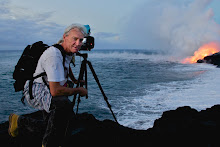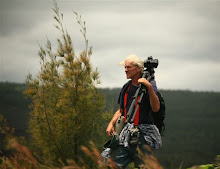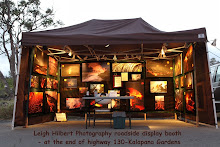NOTE: watch it on this page or double click the video and watch it full size on YouTube or click HERE
This seven-minute video is of lava burning the forest in the kipuka. In this short movie, shot April 23rd at dawn, you will see trees fall into the molten lava and burst into flames (@1:40 and another @1:55). The last few minutes shows a lava breakout pour down into ferns (@3:30) and bursting larger (@4:40). Throughout the movie you will here the crackling of fires, thumps of small methane gas explosions, at least five varieties of birds chirping and one croaking buffo toad...
 The above aerial was originally from a USGS images update on April 15th .(Click the image for larger size) I have added my own update notes to it. The red surface flow outline is a rough interpretation of where the hot zones are, but close enough to show how it is advancing into the kipuka newer the viewing area shown in my opening image.
The above aerial was originally from a USGS images update on April 15th .(Click the image for larger size) I have added my own update notes to it. The red surface flow outline is a rough interpretation of where the hot zones are, but close enough to show how it is advancing into the kipuka newer the viewing area shown in my opening image. Further up the coastal flats and Pulama Pali beyond we still see some serious swaths of lava that stand out red & orange after dark. Those more distant pali flows have dimmed a little the past 24 hours as they crust over and form tubes; or as they stagnate.
Lava Viewing Summary:
Weather permitting; the most visual displays of active lava continue to be safely witnessed from the two designated public viewing areas:
1) The balcony outside the Jaggar Museum during the day and after dark. The Jaggar is located a few miles past the entrance gates of Hawaii Volcanoes National Park and is open to the public 24 hour a day, seven days a week.
2) The newly advancing surface flow can be watched from the Hawaii County Civil Defense public viewing area parking, trailhead and the newly established gathering spot next to there. This area may become pretty exciting in the following days IF the lava close by continues its march through the kipuka forest and passes through, or nearby. The viewing area is open to the public between the hours of 2:00 PM and 10:00 PM; last car allowed in is 8:00 PM – seven days per week.










No comments:
Post a Comment